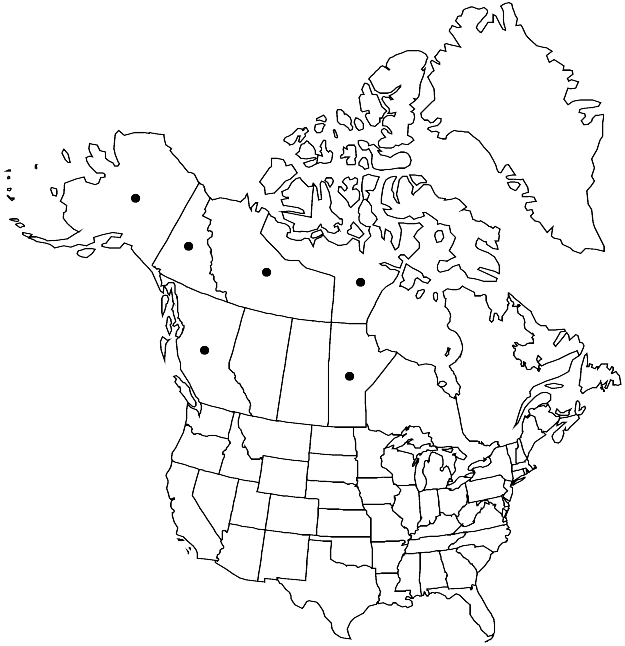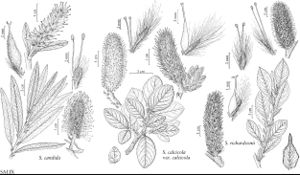Salix richardsonii
Fl. Bor.-Amer. 2: 147, plate 182. 1838.
Plants 0.3–6.5 m. Stems: branches redbrown, yellowbrown, or violet, not to strongly glaucous (slightly or highly glossy), villous to glabrescent with persistent patches of hairs; branchlets redbrown or yellowbrown, pilose to densely villous, (buds caprea-type, scale inner membrane free, separating from outer layer). Leaves: stipules (sometimes marcescent), foliaceous, (3–12–35 mm, 1.7–3.6–6.6 times as long as wide, lanceolate or narrowly elliptic, sometimes ovate or oval, base broad, abruptly tapering), apex acuminate or acute; petiole convex to flat or shallowly grooved adaxially, 2–7.3–27 mm, villous to glabrescent adaxially; largest medial blade broadly to narrowly elliptic, or obovate, 23–45–100 × 10–22–55 mm, 1.2–2.2–4.2 times as long as wide, base cuneate, convex, or concave, margins slightly revolute or flat, entire or serrulate, apex acute, acuminate, or convex, abaxial surface glaucous, glabrous or pilose, hairs (white, sometimes also ferruginous), curved, adaxial slightly glossy, moderately densely villous or pilose to glabrescent; proximal blade margins usually entire, sometimes serrulate; juvenile blade yellowish green, abaxially densely villous or pilose, sometimes glabrous, hairs white, sometimes also ferruginous. Catkins flowering before leaves emerge; staminate stout or subglobose, 22–53 × 16–24 mm, flowering branchlet 0 mm; pistillate densely flowered, slender or stout, 25–69 (–85 in fruit) × 13–20 mm, flowering branchlet 0–2 mm; floral bract brown or black, 2.4–3.2 mm, apex acute, rounded, or retuse, abaxially moderately densely hairy, hairs straight. Staminate flowers: adaxial nectary narrowly oblong to oblong, 0.7–1.8 mm; filaments distinct to connate ca. 1/2 their lengths, glabrous; anthers purple turning yellow, ellipsoid to shortly cylindrical, 0.5–0.8 mm. Pistillate flowers: adaxial nectary narrowly oblong, oblong, or flask-shaped, 0.6–1.4 mm (2+-lobed), longer than stipe; stipe 0.4–1 mm; ovary pyriform, beak gradually tapering to styles; ovules 22–37 per ovary; styles 1–2.8 mm; stigmas slenderly cylindrical, 0.32–0.63–0.86 mm. Capsules 4.5–6.8 mm. 2n = 38.
Phenology: Flowering late May-early Jul.
Habitat: Arctic, subarctic, subalpine and boreal, stream terraces and floodplains, open forests, wet sedge meadows, fens, drumlin fields, gravel ridges, bogs, cliff ledges, snowbeds, silt, sand and gravel, calcareous or igneous substrates
Elevation: 10-1800 m
Distribution

B.C., Man., N.W.T., Nunavut, Yukon, Alaska, e Asia (Chukotka), e Asia (Kamchatka), e Asia (Russia [Anadyr]), e Asia (e Siberia)
Discussion
Hybrids:
Salix richardsonii forms natural hybrids with S. barclayi and S. calcicola.
Selected References
None.
Lower Taxa
"-100mm" is not declared as a valid unit of measurement for this property."-55mm" is not declared as a valid unit of measurement for this property."-27mm" is not declared as a valid unit of measurement for this property."-0.86mm" is not declared as a valid unit of measurement for this property.
